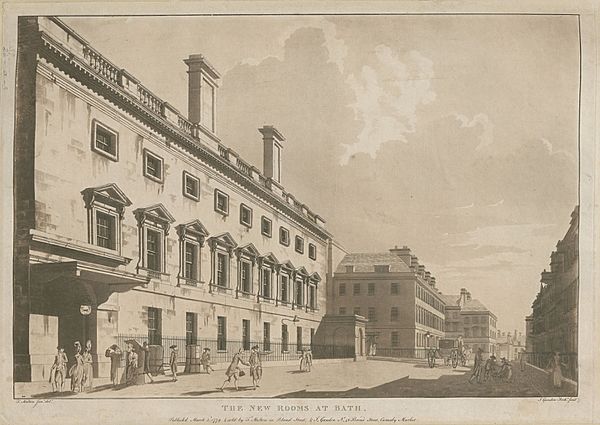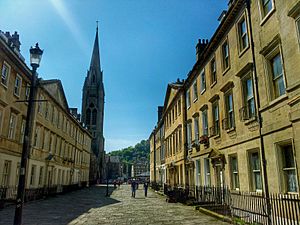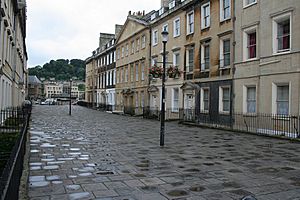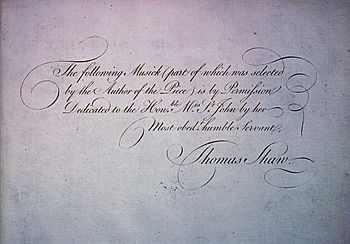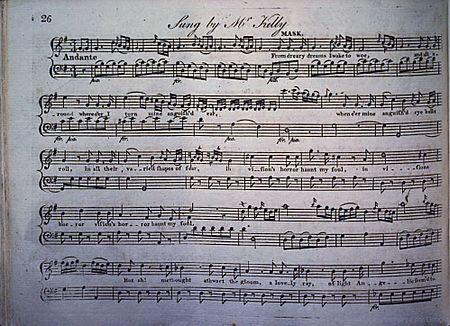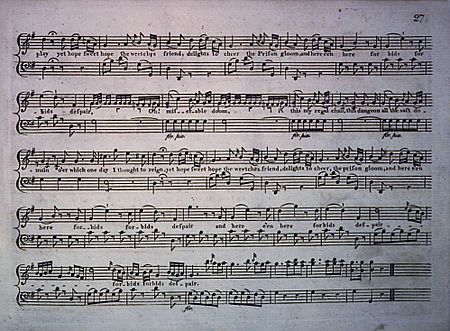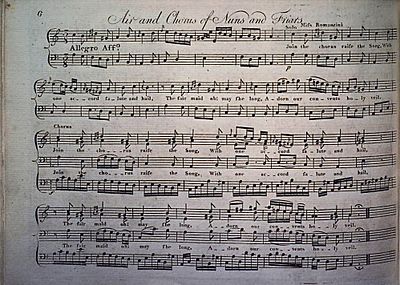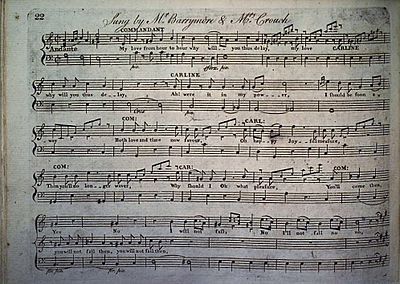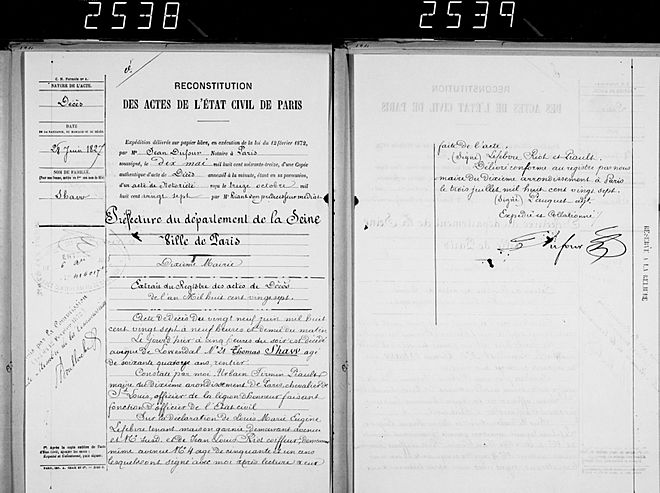Thomas Shaw (composer) facts for kids
Quick facts for kids
Thomas Shaw
|
|
|---|---|
| Born | c.1752 probably Bath, Somerset, England
|
| Died | 28 June 1827 (aged 74) or c.1830 probably Paris, France
|
| Resting place | unknown |
| Nationality | English, British |
| Occupation |
|
| Spouse(s) | Mrs "Thomas Shaw Jun." (actress) |
| Parent(s) | Thomas Shaw (father, 1715–92, Contrabassist) |
| Relatives | Anthony Shaw (brother, 1747–92, violinist) |
Thomas Shaw was a talented English musician. He played the violin, viola, and clarinet. He was also a composer, meaning he wrote music. Thomas was born around 1752, likely in Bath, England. He probably passed away in Paris, France, around 1827 or 1830.
Thomas Shaw's father, also named Thomas Shaw, was a well-known musician. His older brother, Anthony Shaw, was also a violinist. Thomas spent most of his career at the Drury Lane theatre in London. There, he played instruments, performed as a violin soloist, led the band, directed music, and wrote music for the theatre.
A famous writer named John Williams even mentioned Thomas Shaw in a poem. He joked about Shaw playing his violin at Drury Lane, calling him a "Violent Democrat" and a "Dictator" of the theatre's band. This shows how important Shaw was at the Drury Lane theatre.
In 1786, a drawing of Thomas Shaw playing the violin was made by Robert Dighton. It was called Shaw-Shaw.
Contents |
Early Life in Bath
We don't know much about Thomas Shaw's early life. His career before moving to London is not very clear.
His father, Thomas Shaw Sr., was a double-bass player. He worked in Bath and London for many years. He was a leading string player and concert director. His father was a respected musician and joined the Royal Society of Musicians in 1754.
Thomas Shaw Jr. was likely born around 1752. In September 1780, when he was about 28, he was suggested for membership in the Royal Society of Musicians. By this time, Thomas was already playing regularly in London. He joined the Drury Lane theatre band by 1778. He also played at the Haymarket theatre in the summers.
Thomas's music career started even earlier. His first known performance was in Bath in April 1769. An advertisement in the Bath Chronicle and Weekly Gazette newspaper mentioned him. It called him "Mr. Shaw, Jun." to tell him apart from his father. This shows he was already well-known.
His last known performances in the Bath area were in Bristol in April 1774 and in Bath in November of the same year. He was a key musician in Bath. He led the orchestra for Thomas Linley's concerts in 1769 and 1770. He was also part of the theatre band in 1771.
Thomas Shaw also composed and published his own music. An overture he wrote was played in a concert in December 1771. By 1772, he was performing his own compositions in Bath and Bristol.
People quickly saw that Thomas Shaw was a very talented musician. He played the violin "in a very masterly Manner and with much Taste." This led to some friendly competition with another young violinist, Thomas Linley junior. Newspapers often compared the two. Shaw was seen as the best at playing the notes on the Fingerboard. Linley was praised for his graceful bowing and beautiful sound.
The Linley family had a strong hold on concerts in Bath and Bristol. Thomas Shaw joined a group of musicians led by William Herschel in 1772. They wanted to challenge the Linleys' control. Shaw played the violin and Herschel played the fortepiano in several concerts together in the spring of 1772.
In June 1772, the Bath Chronicle and Weekly Gazette advertised their concerts. They performed sacred music, including famous pieces like Allegri's Miserere. Shaw played the first violin and a solo.
Another concert for Thomas Shaw's benefit was advertised in December 1772. It took place in Bath. Shaw played the first violin. William Herschel played the harpsichord. Thomas Shaw lived in Duke Street at this time.
Around 1776, Thomas Shaw decided to move to London for more opportunities. His brother Anthony was already working there as a musician. Thomas was still in his early twenties. He had already played some of his music in London at the Vauxhall Gardens in 1773. Even in London, he would sometimes work with the Linley family.
Career in London
Records show that Thomas Shaw worked at the Vauxhall Gardens as a musician and composer in the early 1790s. He might have worked there more often, but not all records have survived.
In February 1793, Thomas Shaw led the band for a "Grand Selection" concert. This concert featured music from many famous composers like Purcell, Mozart, and Handel.
Shaw also showed his violin skills by playing special parts in songs. For example, in March 1793, he played the violin part for Mrs. Ferguson's performance of Handel's Sweet Bird. In August and September 1793, he played for Miss Gopell's first London performance. He played the violin part in the song Sweet Echo.
At the Drury Lane Theatre
By 1778, Thomas Shaw had joined the band at the Drury Lane theatre in London. He became the leader of the band in March 1786. This was for the first show of Redemption, an oratorio with music by Handel and Samuel Arnold. He kept this important job for about 23 years, until 1809.
Shaw often performed violin solos at Drury Lane. He played special violin parts that went along with singers. He also performed full violin concertos between parts of plays or oratorios like Messiah.
By 1786, Shaw's role was more than just leading the band and playing solos. He also helped direct the music for the whole theatre. A famous singer named Michael Kelly once told a story about Shaw. During a rehearsal, Shaw told the main actor, John Philip Kemble, that he was "murdering the time." Kemble calmly replied that it was better to "murder time at once than be continually beating him as [Shaw] did." Despite this, another musician, Charles Dibdin, thought Shaw was a much better leader than others.
Besides playing and directing, Thomas Shaw also wrote music for Drury Lane shows. His first major work was the 1789 opera The Island of Saint Marguerite. Shaw composed some of the music and put together other parts.
He also wrote other instrumental pieces, like chamber music and piano sonatas. He composed a violin concerto and various operatic pieces. These included overtures, songs, and marches. His music was used in new shows or added to older ones.
For example, he wrote an overture and other instrumental parts for the 1791 revival of Cymon. Some of his music was published, but most of it only exists as keyboard arrangements today. Shaw continued to be the leader of the band until at least 1800.
In March 1794, a "Grand Selection of Sacred Music from the Works of Handel" concert took place at Drury Lane. The stage was decorated to look like a "Gothic Cathedral." Shaw led the band, playing under the direction of Linley Sen. and Stephen Storace. Famous singer Nancy Storace was one of the soloists.
The Island of Saint Marguerite
The French Revolution and the wars between Britain and France were big news. They inspired many British composers. Thomas Shaw's opera, The Island of Saint Marguerite, was one of the first. It opened on November 13, 1789. This was just four months after the storming of the Bastille, which was a major event in the French Revolution. The opera was inspired by this event.
The opera was originally going to be called "The Iron Mask." This was a reference to a mysterious prisoner at the Bastille prison. However, the government office in charge of plays didn't like the political message. So, many changes were made. All mentions of recent events in France were removed from the play.
The authors chose a less obvious reference to French prisons. They picked Sainte-Marguerite, an island where the "Man in the Iron Mask" was held prisoner. Not much of the original idea remained after the changes. A review said that the scenery was beautiful, the actors were good, and the music was well chosen.

Shaw composed some of the music for the opera, including the overture, songs, and choruses. However, other parts of the music were borrowed from other composers. For example, the opening chorus was from Geminiani. A duet in Act I was from Mozart's Le nozze di Figaro.
Story of the Opera (Synopsis): A young lady named Carline wants to escape from a convent. She plans to do this with the help of the Commandant, who runs a nearby prison. The prison holds a young man with an iron mask. He throws a silver plate with his name on it into the moat. A fisherman named Jonas finds it. The Commandant finds out, but since Jonas can't read, he lets him go. Jonas helps the Commandant get into the convent. Carline escapes by dressing as a man.
Later, Carline convinces the Commandant to let her see the prisoner. She discovers he is her own brother! The Commandant orders them both to be locked up. But the townspeople find out the prisoner is of royal birth. They fight the soldiers and free him. The play ends with their freedom.
Original Actors in November 1789:
| Role | Actor |
| Mask (the prisoner) | Michael Kelly |
| Commandant | Mr Barrymore |
| Turnkey | Mr Suett |
| Lawyer | Mr Waldron |
| Officer | Mr Sedgewick |
| Thomas | Mr Banks |
| Jonas | Mr Bannister jun. |
| Carline | Anna Maria Crouch |
| Nannette | Miss Romanzini (Maria Bland) |
| Abbess | Mrs Eliza Edwards |
| Teresa | Mrs Fox |
| Nuns | Miss Hagley, Miss Stageldoir, Miss Barnes |
| Mob | Mr Hollingsworth, Mr Jones, Mr Phillimore, Mr Maddocks, Mr Lyons, Mr Fairbrother, Mr Webb |
| Extras | Mr Fawcett, Mr Wilson, Mr Alfred, Mr Danby, Mr Shaw, Mr Vincent, Mr Boyer, Mr Stageldoir, Mr Horsfall, Mr Dorion, Mr Capon.
Mrs Edwin, Miss Palmer, Mrs Shaw, Mrs Davies, Mrs Butler, Mrs Gawdry |
| Narrator | Mr Bannister Jun. |
The opera was quite popular. It was performed 38 times over three seasons at Drury Lane.
Money Troubles
Theatre records show that Thomas Shaw was paid well at Drury Lane. In 1802, he earned £8 a week. By 1805, it went up to £10 a week. He also got paid for his compositions.
However, Sheridan, the manager of Drury Lane, often didn't pay Shaw the full amount he was owed. Even though Thomas Shaw owned a small part of the theatre, he faced serious money problems because Sheridan didn't pay him.
In July 1808, Sheridan still owed Shaw a huge amount of money. When the Drury Lane theatre burned down in 1809, Sheridan was financially ruined. To help with the theatre's many debts, Sheridan asked Samuel Whitbread for help. Whitbread took over managing the theatre and rebuilding it.
In May 1810, Sheridan offered Shaw a larger share in the theatre. A year later, Sheridan was still promising to pay Shaw, but he had no money left. Whitbread, the new head of Drury Lane, offered Shaw a settlement. Shaw refused this offer.
By 1815, Shaw and Sheridan were still arguing about the money. This is the last time Thomas Shaw is mentioned in London records.
Later Life and Career
In March 1811, George Colman, who managed the Little Theatre in the Hay, offered Shaw a job as "President of the Orchestra." It's not clear if Shaw accepted.
In late 1811, Shaw tried to get a job as leader of the band at the Lyceum Theatre. He was not successful. He felt that false rumors were being spread about him. He blamed Thomas Sheridan (the son of the Drury Lane manager) and Samuel James Arnold, who were involved with the Lyceum.
In 1816, he returned to the Vauxhall Gardens as a leader. It's not known why Thomas Shaw left England between late 1816 and 1817. He might have left to escape his debts.
In 1817, Thomas Shaw was in Paris. He composed and published an anthem called "Heavenly choir, assist our strain." This song was performed at a funeral service in Paris for Princess Charlotte of Wales. The song's title mentioned that it was composed by "Thomas Shaw, late Leader of the Band at the Theatre Royal Drury Lane and Vauxhall."
A few years later, a young Fanny Kemp was at school in Paris. She met Thomas Shaw there, where he was teaching music in the 1820s. This is the last known record of Thomas Shaw.
Death
Most people believe Thomas Shaw died in Paris around 1830. This is based on where he was last seen and his age.
Many old records in Paris were destroyed in 1871. However, there is a death record for a Thomas Shaw in Paris. It states that a 74-year-old Thomas Shaw died on June 28, 1827.
Our musician Thomas Shaw was born around 1752. This would make him about 74 or 75 in June 1827. So, it's very possible that this death certificate belongs to him. The record says he was a "rentier," which meant he lived off money that wasn't a regular salary, perhaps from property or investments. Since we don't know much about Shaw's life after he left England, this information doesn't confirm or deny if it's him.
Because of the lost records, we can't be completely sure if the Thomas Shaw who died in Paris in 1827 is the same Thomas Shaw, the musician and composer. But it's a strong possibility.
Private Life
Haydn's Visit
The famous composer Haydn wrote about visiting Thomas Shaw for lunch in September 1791. Shaw was a big fan of Haydn. He wore a coat with Haydn's name sewn into the collar. Shaw's wife and two daughters also wore headpieces with Haydn's name embroidered in gold.
Shaw asked to trade tobacco boxes with Haydn as a souvenir. A few days later, Shaw's box was put in a silver case with "gift from the most famous Joseph Haydn" engraved on it. Haydn also received a stick-pin from Mrs. Shaw, whom he thought was "the most beautiful woman [he] ever saw."
Margate Theatre
When his brother Anthony died in 1792, Thomas Shaw received a share in the Margate theatre. He was involved with this theatre until 1813.
Works
Instrumental Music
| Violin Concerto in G Major (published around 1785) |
Chamber Music
| Six Favourite Minuets (published in Bath, 1774) |
| String Trio in G minor (around 1805) |
| Solo for flute op.12 (1819) |
Music for Keyboard
| Three Sonatas for the Harpsichord or the Piano Forte (1787) |
| 3 Keyboard Sonatas (1790) |
| 3 Pianoforte Sonatas op.9 (around 1803-04) |
| 3 Pianoforte Sonatas op.13 (1805–14) |
Stage Works
| The Island of St Marguerite (1789)
A two-act comic opera. The story was by John St. John and Sheridan. Music was by Thomas Shaw, with some parts borrowed from Geminiani and Mozart. |
| Cymon (1792)
Original music by Michael Arne. Thomas Shaw wrote the overture and some instrumental parts, like the Marches in the Procession. |
| The Merchant of Venice (1792-9)
Includes the duet In Vows of Everlasting Truth by Thomas Shaw. |
| The Mariners (1793)
Music mainly by Thomas Attwood. Thomas Shaw composed the overture. |
| The Chimney Corner (1797)
Overture composed by Thomas Shaw. |
| The Stranger (1798-9)
Thomas Shaw's music includes the songs: To Welcome Mirth and Harmless Glee and I Have a Silent Sorrow Here. |
| Cambro-Britons (1798)
This play uses the song I Have a Silent Sorrow Here from The Stranger. |
| The Shipwreck (1798)
This play uses the song There Stood Jonas from The Island of St Marguerite. |
| De Montfort (1800)
Music for the 3rd act composed by Thomas Shaw. |
Other works where Shaw contributed music:
|
Songs
| The Happy Milkmaid (1775) |
| The Four Saints (1801) |
Sacred Music
| "Heavenly choir, assist our strain" (1817)
An anthem performed at the funeral service for Princess Charlotte of Wales in Paris. |
Discography
- The overture to The Island of St. Marguerite can be found on the album:
Great Britain Triumphant! by Capella Savaria, conducted by Mary Térey-Smith (Centaur Records, 2011).
- The Violin Concerto in G is available on the album:
English Classical Violin Concertos, featuring Elizabeth Wallfisch and The Parley of Instruments, led by Peter Holman (Helios, 2008).
Images for kids


